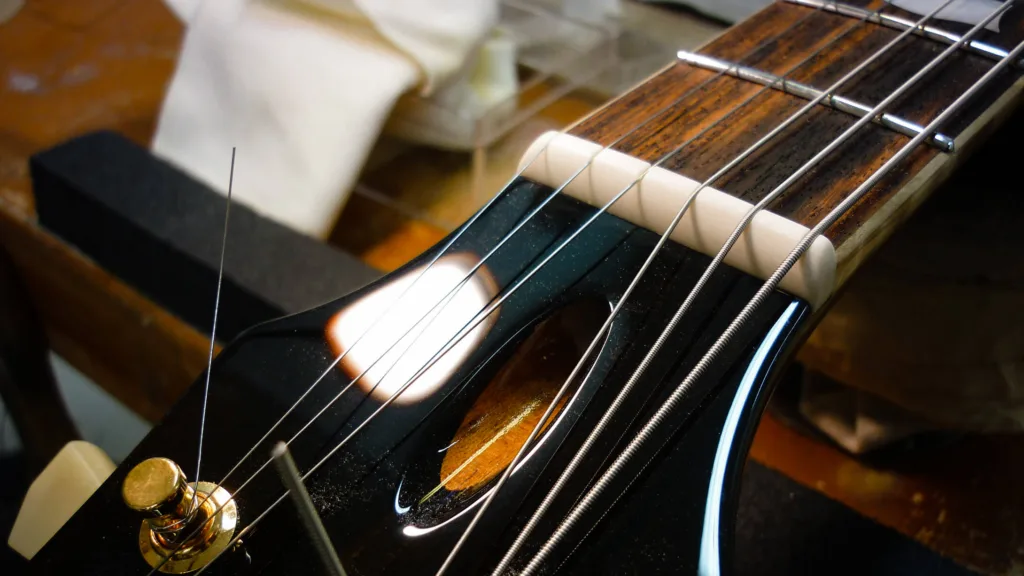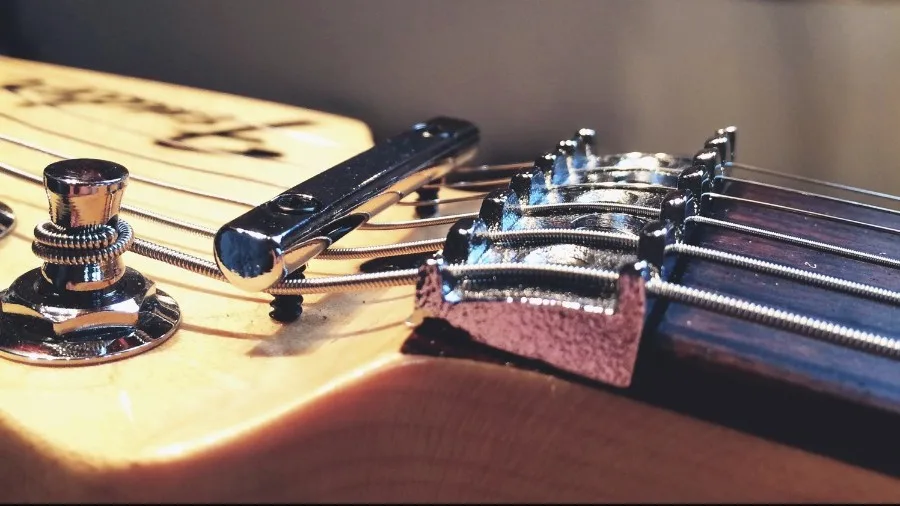What is the nut on a guitar called? If you’re new to playing guitar, this may seem like a simple question with an obvious answer. However, as a beginner, it’s important to understand the different parts of your instrument and what they’re called. The nut is just one of several crucial components that make up a guitar. Don’t worry if you don’t know much about guitars yet – I’ve got you covered!
In this guide, we’ll take a closer look at the anatomy of a guitar and focus specifically on the importance of the nut. We’ll explore its role in holding strings in place and shaping their sound, as well as how to properly maintain it for optimal performance. Whether you’re just starting out or looking to expand your knowledge as an experienced player, this article will provide valuable information for any guitarist curious about what exactly that little piece at the top of their fretboard is called.
So, what is the nut on a guitar?
The nut on a guitar is an essential component that often goes unnoticed by beginner players. It is a small piece of material, usually made of plastic or bone, located at the top of the fretboard where the strings sit before they reach the tuning pegs. The purpose of the nut is to keep the strings in place and maintain proper spacing between them for accurate playing. It also helps with string tension and allows for smoother tuning. Without a properly functioning nut, it would be difficult to play any chords or notes correctly on a guitar. So while it may seem like just a small detail, the nut plays an important role in producing quality sound from your instrument.
Understanding the Role and Significance of the Nut on a Guitar
The nut of a guitar, often made from materials like bone, plastic, or synthetic compounds, plays a vital role in determining how the instrument sounds and feels. Positioned at the top of the neck where it meets the headstock, this small but mighty piece is responsible for holding the strings in place while ensuring they are spaced evenly apart. Proper string spacing allows for easier playing and better intonation. When you press down on a string to create notes or chords, it’s crucial that it sits comfortably over the nut without excessive height or friction; otherwise, it can lead to tuning issues and an uneven tone.
Moreover, the nut influences not only playability but also contributes to overall resonance and sustain. The material used can absorb vibrations differently; for instance, bone tends to enhance sound richness compared to plastic alternatives. A well-crafted nut allows vibrations from plucked strings to travel freely into the neck of the guitar—a process that enriches harmonics and tone quality. In summary:
- Holds strings in position
- Affects playability
- Contributes to sound quality
Understanding its significance helps players appreciate their instrument even more!
Read also: did ralph macchio play guitar in crossroads
Exploring Different Types of Nuts and Their Impact on Guitar Sound Quality
When it comes to guitars, the choice of materials can significantly influence their sound quality, and one fascinating aspect is the use of various nuts. The nut, typically located at the top of the neck near the headstock, plays a crucial role in string height and spacing. Different nuts can create distinct tonal qualities that vary depending on their construction material. For instance, bone nuts often produce a bright and clear tone due to bone’s density and natural resonance. On the other hand, graphite nuts are known for their smooth surface which helps with tuning stability while offering a warmer sound.
Another interesting option is plastic, commonly found on budget-friendly guitars. While not as resonant as bone or graphite, plastic still serves its purpose well; it provides adequate performance without breaking the bank. Additionally, there are exotic choices like brass or even tusq, which blend synthetic materials with organic elements for enhanced sound projection and sustain. Each nut material contributes uniquely to how notes resonate when plucked or strummed—creating overtones that add richness to music played on these instruments.
- Bone – Bright and clear tone
- Graphite – Smooth surface & warmer sound
- Plastic – Affordable yet functional
- Brass/Tusq – Enhanced projection & sustain
Understanding these diverse options allows musicians to tailor their instruments more closely to their personal sonic preferences.

How to Maintain and Replace the Nut on a Guitar for Optimal Performance
Taking care of your guitar’s nut is essential for its sound and playability. The nut, often made from materials like bone, plastic, or brass, plays a crucial role in guiding the strings into the tuning pegs and ensuring they stay in tune. To maintain it properly, start by regularly checking for wear and tear. Look out for grooves where the strings sit; if you notice any deep indentations that could cause buzzing or poor intonation, it’s time to consider replacing it. A simple cleaning with a soft cloth can also help keep grime at bay.
If you decide to replace your guitar’s nut, begin by loosening the strings carefully so you don’t damage them. Gently pry off the old nut using a thin blade or flat tool—be cautious not to scratch your instrument! Once it’s removed, clean the slot thoroughly before measuring for size; this ensures that your new nut will fit snugly without gaps. When you’re ready to install a new one, apply a little glue just enough to hold it in place while making sure it sits evenly in its slot. Finally, restring your guitar and give everything another look to ensure optimum performance—an easy but effective way to elevate your playing experience!
The Connection Between The Nut And Other Guitar Components
The nut of a guitar might seem like a small and simple part, but it plays an essential role in the instrument’s overall sound and playability. Located at the top of the neck, just before the headstock, this tiny piece is usually made from materials such as bone, plastic, or graphite. The nut has grooves that guide the strings into their proper positions. When you pluck or strum a string, its vibration travels through these grooves into the guitar’s body. This means that if your nut is not perfect—say it’s too high or too low—it can affect how easily you play and even change your tone! A well-cut nut ensures that each note rings out clearly.
Moreover, the connection between the nut and other components goes beyond just holding strings in place; it affects intonation and tuning stability as well. For instance, when strings pass over a properly shaped nut, they maintain better alignment with frets along the neck. If there are issues at this point—like uneven string heights—it might lead to buzzing sounds or difficulty hitting specific notes accurately. In essence,
the quality of your guitar’s nut influences everything from playability to sound quality, making its role vital for any guitarist aiming to achieve perfection in their music-making journey.
You may also like: what guitar does slash use
Conclusion: Emphasizing the Importance of Knowing Your Guitar’s Anatomy
Understanding your guitar’s anatomy is crucial for both beginners and seasoned players alike. Each component, from the headstock to the body, plays a vital role in creating that beautiful sound we all love. The body, for instance, acts as a resonator; its shape and material greatly influence tone quality. Whether you’re strumming a sweet melody or picking out intricate solos, knowing how these parts work together can help you enhance your playing experience. Familiarizing yourself with components like the fretboard, where all those frets lie waiting for your fingers to dance upon them, makes it easier to develop techniques that suit your style.
Moreover, understanding why certain aspects of construction matter enables you to make informed choices when purchasing or maintaining your instrument. Do you know why some guitars come with rosewood versus maple fretboards? Or how changing strings affects playability? This knowledge allows musicians to experiment confidently with different setups—like trying lighter gauge strings for easier bends and vibratos or adjusting action height to improve comfort during long practice sessions. By grasping each element’s role in shaping sound and feel, players foster a deeper connection with their instruments while embarking on their musical journeys.
Ultimately, this understanding elevates not just performance but also appreciation of what goes into crafting beautiful music.

